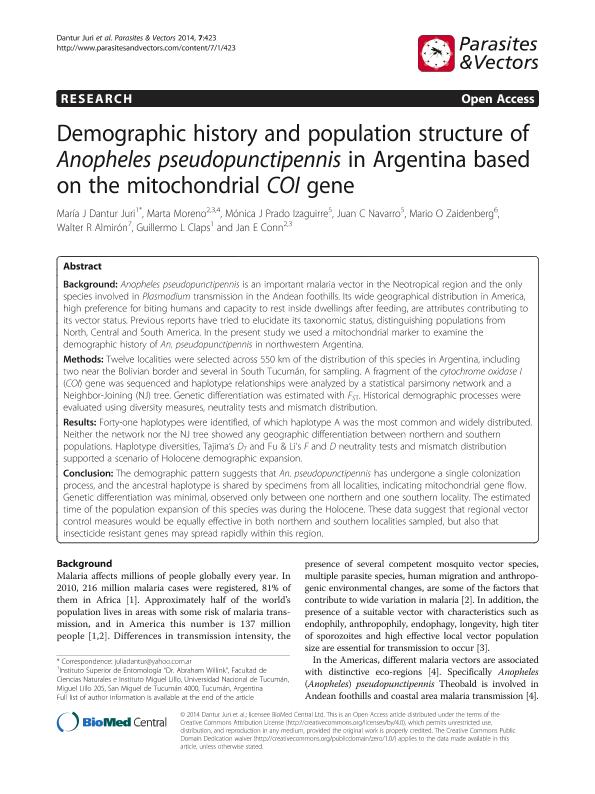Mostrar el registro sencillo del ítem
dc.contributor.author
Dantur Juri, Maria Julia

dc.contributor.author
Moreno, Marta
dc.contributor.author
Prado Izaguirre, Mónica J.
dc.contributor.author
Navarro, Juan C.
dc.contributor.author
Zaidenberg, Mario O.
dc.contributor.author
Almiron, Walter Ricardo

dc.contributor.author
Claps, Guillermo Luis

dc.contributor.author
Conn, Jan E.
dc.date.available
2017-02-06T21:34:09Z
dc.date.issued
2014-09
dc.identifier.citation
Dantur Juri, Maria Julia; Moreno, Marta; Prado Izaguirre, Mónica J.; Navarro, Juan C.; Zaidenberg, Mario O.; et al.; Demographic history and population structure of Anopheles pseudopunctipennis in Argentina based on the mitochondrial COI gene; Biomed Central; Parasites And Vectors; 7; 423; 9-2014; 1-9
dc.identifier.issn
1756-3305
dc.identifier.uri
http://hdl.handle.net/11336/12588
dc.description.abstract
Background: Anopheles pseudopunctipennis is an important malaria vector in the Neotropical region and the only species involved in Plasmodium transmission in the Andean foothills. Its wide geographical distribution in America, high preference for biting humans and capacity to rest inside dwellings after feeding, are attributes contributing to its vector status. Previous reports have tried to elucidate its taxonomic status, distinguishing populations from North, Central and South America. In the present study we used a mitochondrial marker to examine the demographic history of An. pseudopunctipennis in northwestern Argentina.
Methods: Twelve localities were selected across 550 km of the distribution of this species in Argentina, including two near the Bolivian border and several in South Tucumán, for sampling. A fragment of the cytochrome oxidase I (COI) gene was sequenced and haplotype relationships were analyzed by a statistical parsimony network and a Neighbor-Joining (NJ) tree. Genetic differentiation was estimated with FS T. Historical demographic processes were evaluated using diversity measures, neutrality tests and mismatch distribution.
Results: Forty-one haplotypes were identified, of which haplotype A was the most common and widely distributed. Neither the network nor the NJ tree showed any geographic differentiation between northern and southern populations. Haplotype diversities, Tajima’s D T and Fu & Li’s F and D neutrality tests and mismatch distribution supported a scenario of Holocene demographic expansion.
Conclusion: The demographic pattern suggests that An. pseudopunctipennis has undergone a single colonization process, and the ancestral haplotype is shared by specimens from all localities, indicating mitochondrial gene flow. Genetic differentiation was minimal, observed only between one northern and one southern locality. The estimated time of the population expansion of this species was during the Holocene. These data suggest that regional vector control measures would be equally effective in both northern and southern localities sampled, but also that insecticide resistant genes may spread rapidly within this region.
dc.format
application/pdf
dc.language.iso
eng
dc.publisher
Biomed Central

dc.rights
info:eu-repo/semantics/openAccess
dc.rights.uri
https://creativecommons.org/licenses/by-nc-sa/2.5/ar/
dc.subject
Mosquitos
dc.subject
Anopheles
dc.subject
Coi
dc.subject
Argentina
dc.subject.classification
Zoología, Ornitología, Entomología, Etología

dc.subject.classification
Ciencias Biológicas

dc.subject.classification
CIENCIAS NATURALES Y EXACTAS

dc.title
Demographic history and population structure of Anopheles pseudopunctipennis in Argentina based on the mitochondrial COI gene
dc.type
info:eu-repo/semantics/article
dc.type
info:ar-repo/semantics/artículo
dc.type
info:eu-repo/semantics/publishedVersion
dc.date.updated
2017-02-03T14:02:54Z
dc.journal.volume
7
dc.journal.number
423
dc.journal.pagination
1-9
dc.journal.pais
Reino Unido

dc.journal.ciudad
Londres
dc.description.fil
Fil: Dantur Juri, Maria Julia. Universidad Nacional de Tucumán. Facultad de Ciencias Naturales e Instituto Miguel Lillo. Instituto Superior de Entomología; Argentina. Consejo Nacional de Investigaciones Científicas y Técnicas; Argentina
dc.description.fil
Fil: Moreno, Marta. New York State Department of Health; Estados Unidos. State University Of New York; Estados Unidos. University Of California At San Diego; Estados Unidos
dc.description.fil
Fil: Prado Izaguirre, Mónica J.. Universidad Central de Venezuela; Venezuela
dc.description.fil
Fil: Navarro, Juan C.. Universidad Central de Venezuela; Venezuela
dc.description.fil
Fil: Zaidenberg, Mario O.. Ministerio de Salud de la Nación. Coordinación Nacional de Control de Vectores; Argentina
dc.description.fil
Fil: Almiron, Walter Ricardo. Universidad Nacional de Córdoba. Facultad de Ciencias Exactas, Físicas y Naturales; Argentina. Consejo Nacional de Investigaciones Científicas y Técnicas; Argentina
dc.description.fil
Fil: Claps, Guillermo Luis. Universidad Nacional de Tucumán. Facultad de Ciencias Naturales e Instituto Miguel Lillo. Instituto Superior de Entomología; Argentina
dc.description.fil
Fil: Conn, Jan E.. New York State Department of Health; Estados Unidos. State University Of New York; Estados Unidos
dc.journal.title
Parasites And Vectors

dc.relation.alternativeid
info:eu-repo/semantics/altIdentifier/doi/http://dx.doi.org/10.1186/1756-3305-7-423
dc.relation.alternativeid
info:eu-repo/semantics/altIdentifier/url/http://parasitesandvectors.biomedcentral.com/articles/10.1186/1756-3305-7-423
Archivos asociados
